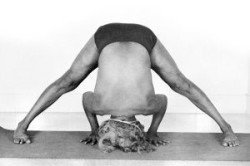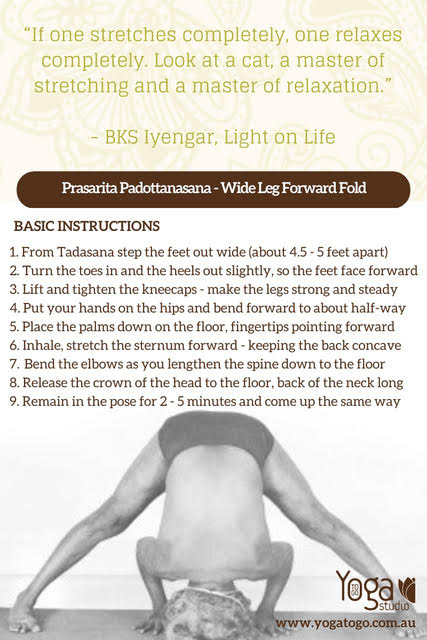Prasarita - expanded, spread, extended
Pada – foot Asana - pose
 This popular standing pose is normally done towards the end of a forward bend class because of it’s deep forward bend action and inversion of the trunk and head.
This popular standing pose is normally done towards the end of a forward bend class because of it’s deep forward bend action and inversion of the trunk and head.
It can provide an intense stretch and be a difficult pose for a beginner BUT it can also be a restful and restorative pose for more advanced students too. Either way, Prasarita Padottanasana helps to develop great strength, balance and flexibility in the body and mind – all at the same time!
In Light on Yoga, BKS Iyengar says that doing this pose sends blood flow to the trunk and head, in a similar way that it does in Sirasana (headstand). Therefore, Prasarita Padottanasana is often done in place of a headstand – a great alternative for those students who are not yet practicing the more advanced inversions.
Other benefits of this pose include:
· Strengthens: spine, back muscles and legs
· Stretches: hamstrings, calves and glutes
· Increases: flexibility in the hip joints
· Improves: digestion and tones the abdominal organs
· Soothes: the brain and helps with depression, headaches and insomnia
Beginner students will often be taught the concave version of this Prasarita Padottanasana first – taking blocks under the hands or even by pressing the hands into the wall and creating a flat back, like a half Uttanasana (standing forward fold). These variations allow students to develop the strength in front and back of the legs, and learn to extend the spine long, rather than curl and hump the back in order to get the head down to the floor.
Holding onto the ankles is another good way to lengthen the whole trunk (front and back body) down to the floor and placing a block under the head can also help to soften and release the top of the shoulders down.
Important note: the final pose with the head resting on the floor is not suitable during later pregnancy – instead do the concave version to the wall or use blocks under the hands to keep the space in the abdomen.
Remember to always practice under the guidance of an experienced and certified Iyengar yoga teacher, let your teacher know of any injuries or health conditions and speak to your doctor or physiotherapist before starting any new exercise programs.
Download our infographic below for some simple instructions and don’t forget to send us your Prasarita Padottanasana questions, tips and photos. Email info@yogatogo.com.au or message and tag us on Facebook, Instagram or Twitter.



